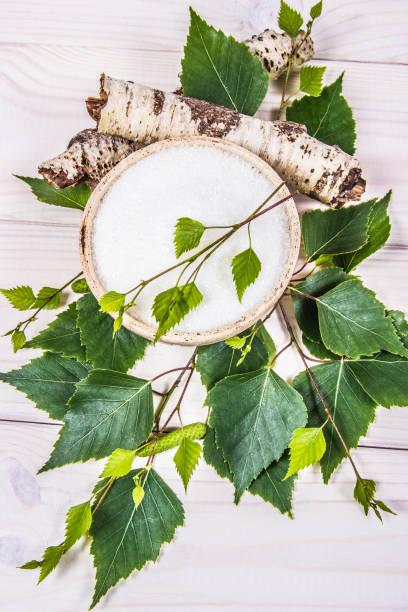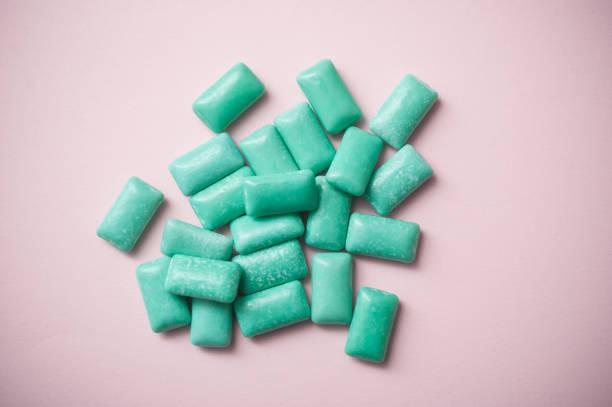Do you know this special little sugar?
It is not exactly a sugar exactly like sugar, but it is very similar: it comes in the form of transparent crystals and is used in the same proportions as white sugar. white sugar.
Small subtle taste however: it has a refreshing effect when it melts under the melts under the tongue.
I want to tell you about about birch sugar, also called also called xylitol.
This sweetener is naturally present in certain fruits such as plums and strawberries, but it is mainly extracted from birch bark because it contains a large amount of birch bark because it contains a large amount of xylitol.
This sugar is particular because it is a polyol, a sugar-alcohol that is part of the FODMAP family (Fermentable Oligosaccharides, Disaccharides, Monosaccharides, Polyols), carbohydrates that ferment in the intestine.
Xylitol has several advantages over table sugar.
Is xylitol less caloric than sugar?
Xylitol has sweetening power equivalent to sucrose, our table sugar. But here is where it is interesting, it is almost 2 times less caloric!
Indeed, one gram of sucrose brings 4 kcal, whileone gram of xylitol brings only 2.4 kcal.
This is because it is absorbed more slowly in our body and is partially eliminated without being metabolized.
Moreover, xylitol has a very low glycemic index of 7 (compared to 65 for table sugar!).
It does not induce a significant insulin peak and is recommended for diabetics.

Is it good for your teeth?
Another surprising fact surprising fact: xylitol not only does not cause cavities... but it protects you from it!
This effect is due to the fact that, unlike sugar, xylitol does not lower the pH of the of the saliva. It is this lowering of the pH that favors the demineralization of the teeth and the demineralization and the appearance of cavities.
In addition, xylitol improves the composition of the oral microbiota: it inhibits the growth of the growth of bacteria responsible for caries because normal oral bacteria cannot cannot feed on xylitol.
Thus, after a few weeks or months of use, xylitol even helps to reduce the risk of gingivitis the risks of gingivitis and periodontitis.
What precautions should I take when consuming xylitol?
One of the only warnings related to the consumption of xylitol concerns the digestive sphere.
Indeed, as mentioned at the beginning of this letter, xylitol is a FODMAP.
If you have suffer from irritable bowel syndrome and must follow a low FODMAP diet, you should diet, you should not consume FODMAPs.
But in any case, even if you don't have even if you do not suffer from irritable bowel syndrome, it is recommended not to recommended not to exceed 50 g of xylitol per day (which is already a lot!) because our body can only metabolize a limited amount. limited amount.
Please note that that this quantity is not fixed and that it depends mainly on your own sensitivity.
Some people could suffer from side effects (bloating, flatulence, diarrhea...) at lower doses.
What are the tips for using birch sugar?

Xylitol is often used as a sweetener in toothpastes, chewing gum or candies because of its cooling effect and its benefits on the oral sphere.
You can also use it pure (you can easily find it in organic stores) and use it for baking.
The nice thing about xylitol is that it is a non-intense sweetener.
This means that it can be used in proportions equivalent to white sugar (unlike some forms of stevia, for example), which makes it very easy to incorporate into cooking, especially since it has no aftertaste.
Nevertheless, here are some tips for cooking with xylitol:
- The xylitol is more adapted to sweeten hot drinks because it dissolves at low temperatures.
- Even even though it is a "healthy" sugar, it is better to reduce the amount of to accustom your palate to less sweet products. In general, classic recipes require almost as much sugar as flour. as flour. On average, I use 40 g of sugar (xylitol) for 100 g of flour. Note that the sweetness of xylitol increases slightly with baking.
- If you have to use large amounts of sugar in a recipe (for example to make a meringue) (for example to make a meringue), it is better to cut the xylitol with conventional cane sugar, so as not to absorb too much xylitol. of xylitol.
On the other hand, xylitol is expensive: when it is extracted from birch bark (and not from corn), it costs birch bark (not corn), it costs almost 20 euros per kilo! One more reason to to use it sparingly...



